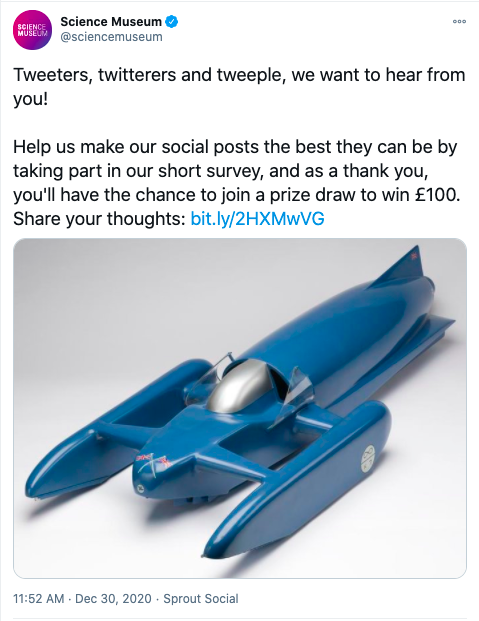Case studies









Using Insight For Change to respond to lockdown and plan for the future
Science Museum Group, UK
The world’s leading group of science museums, with collections spanning science, technology, engineering, medicine, transport and media.
Services: Insight for Change
Tools: Web and social audience research, Peer data and collaboration, Insight workshops + reports.
Delivered: 2020 – 2021
The ask.
In a normal year the Science Museum Group (SMG) attracts more than five million visitors through their doors. At a time when all venues have had to close, how can we better understand and service our web and social audiences?
The motivation.
SMG has had to make some rapid changes to their website and social content in response to Covid-19 and lockdown. As well as an overall shift in content narrative, they’ve introduced new ticket booking systems and ways for supporters to donate digitally. They need to understand what the impact of these changes are, how and why audiences are connecting with content now, and make informed decisions about new opportunities.
The approach.
SMG has venues across London, Bradford, Manchester, Shildon and York. Along with all other indoor visitor attractions in the UK, their museums had to totally rethink audience engagement because of the pandemic. SMG were one of the first six UK and US organisations to commission our Insight For Change package.
We started working with SMG to deliver this 12 month-project in late 2020 and have just completed the first phase of their web and social audience research study.

The outcome so far.
In 2017 we worked with SMG to deliver audience research ahead of a website redesign. And then on an action research project to support content teams adopt a user-centred approach to content design; including designing frameworks that enhance the discoverability and value of stories for their online audiences. Because of this earlier work, this latest research will benefit from some pre-established benchmarks.
Insights from the research and workshops will be used with Curatorial teams to help ensure collections and objects continue to connect with audiences in the absence of physical exhibitions and visits. Knowledge of audience behaviour and motivation, will help inform Development teams as they explore new digital opportunities for sponsors and donors.
For the first time, SMG’s Digital and Communications teams will have a comparative data set of both their online and social audiences. By exploring the similarities and differences, and how these measure with visitor audiences and other cultural organisations, they’ll make informed decisions on content design and placement across digital channels and platforms.
Website Editor, Rosie Cardiff, explains:
“Across our museums, we have a lot of data about who our physical visitors are as well as analytics for engagement in campaigns, adverts and web content. We don’t have that up-to-date, detailed understanding about who our web and social audiences are, how and why they interact with content across the whole website, what they are interested in, what they are likely to support and why? This is essential insight for teams across the organisation as we navigate lockdown and plan for life beyond.”
Up next
Following the first round of research and a review of their live data portal, we are working closely with SMG to design an Insights and Next Steps Workshop; to be succeeded by a FG+W report and the second round of research. The outcomes will inform digital content design and placement decisions across platforms and channels. Through Insight For Change, SMG are also able to benchmark against anonymised peer data sets and will be included in a sector report and collaborative research study.
–Rosie Cardiff, Web Editor, Science Museum Group
“The surveys tell us more about the behaviour of our web and social audiences in terms of whether they donate and support cultural organisations and what types of digital content they pay for currently. This isn’t something we’ve captured in this way before and these insights will be really interesting.”
Share this case study.
